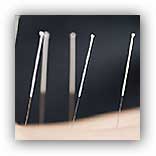|
Providers at the Yale Stress Center are sticking
needles in people—and providing significant relief
from symptoms for many of them.
The Stress Center began offering acupuncture last
year primarily to treat chronic pain, but also to
treat such conditions as anxiety, depression,
fatigue, insomnia, and migraines, as well as nausea
induced by chemotherapy. The list goes on..
I
“Patients do want to have options, and acupuncture
is another tool,” said Eunjie Klegar, M.D., a Yale
Medical Group psychiatrist who studied acupuncture
at Harvard during her psychiatry residency and is
one of two providers using it at the Yale Stress
Center. “People hold stress or anxiety in different
body areas. Acupuncture treatments can help retrain
the body so that the same pain pathways are not
being used all the time,” she said.
Acupuncture is the stimulation of specific pressure
points along the skin of the body using thin needles,
and it comes in different forms. Dr. Klegar
practices a Japanese, palpation-based style of
full-body acupuncture that involves palpating a
reflex point as well as another more distal point
where she inserts the needle to provide relief. “The
patient might feel pain, or I might feel tightness
that I can use to determine the distal point that
will give instant feedback on that reflex,” Dr.
Klegar said.
Xoli Redmond, PsyD., a Yale Stress Center
psychologist, is certified in the administration of
auricular, or ear acupuncture, a treatment that
involves inserting very fine, sterile needles into
five key points in the ear. The needles are inserted
for up to an hour, during which time the client sits
comfortably and quietly, listening to relaxing music
and not speaking.
Patients need not be concerned about pain, said Dr.
Klegar. “The needles are very thin—about the
thickness of a human hair, and they’re not hollow.
Sometimes you can feel the initial pin prick of a
needle going in. Some patients don’t notice it;
others think it hurts.” Any feeling of pain usually
depends on point on the body where the needle is
inserted, she said. “There are certain points that
are more sensitive than others.” When Dr. Klegar
needs to work with an especially sensitive pressure
point, she talks to the patient first to make sure
they want to continue.
The number of visits required to complete a course
of acupuncture treatment varies widely. Dr. Klegar
recommends starting with six to eight sessions.
Patients with longstanding, chronic issues may
choose to visit the center weekly for several weeks;
those with acute problems might benefit from more
frequent treatments. Acupuncture often works best as
part of an overall treatment plan, said Dr. Klegar,
who has used it to complement medical care or
medication, and in cases where medication is not
helping.
There are no guarantees that acupuncture will work
consistently for everyone—while the technique has
been practiced for millennia in China, it hasn’t
been studied as extensively as mainstream Western
medicine. Research has shown that acupuncture can
help manage certain pain conditions, and it has been
found to benefit veterans returning from war zones
with chronic pain and coping with trauma-related
conditions. However, evidence about its value for
other issues is still uncertain.
The National Center for Complementary and
Alternative Medicine (NCCAM), which is a part of the
NIH, has reported that 3.1 million people tried
acupuncture in 2007, a million more than in 2002.
People surveyed used it to relieve discomfort caused
by fibromyalgia, chemotherapy-induced nausea and
vomiting, low back pain, and other ailments.
Anecdotally, Dr. Klegar said, most of her patients
benefit in some way. “Some find relief right away.
But the general rule of thumb is if you have a
chronic condition, don’t expect a cure in one
session. The body has to heal itself and you have to
give it time to readjust.”
For more information
Yale School of Medicine
MDN |